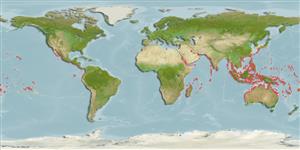Cephalopoda |
Octopoda |
Octopodidae | Octopodinae
Environment: milieu / climate zone / depth range / distribution range
Ecology
Reef-associated; depth range 0 - 10 m (Ref. 96968). Tropical
Indo-Pacific.
Length at first maturity / Size / Weight / Age
Maturity: Lm ? range ? - ? cm Max length : 120 cm TL male/unsexed; (Ref. 96968); max. published weight: 1.0 kg (Ref. 96968)
It's mantle length is 13 cm (Ref. 96968). Minor harvests are known within the region. Occurs in shallow tropical (Ref. 96968) and subtropical waters (Ref. 106867) on coral reefs (Refs. 96968, 106867). Occupies temporary lairs within coral rubble with deep vertical holes as entrance, which are sealed during the day with rubble. At night, it forages over reef flats or at gravel substrate on sandy bottoms during low tide. Primarily feeds on fishes, crustaceans and octopuses (Ref. 101159).
Life cycle and mating behavior
Maturity | Reproduction | Spawning | Eggs | Fecundity | Larvae
Members of the class Cephalopoda are gonochoric. Male and female adults usually die shortly after spawning and brooding, respectively. Mating behavior: Males perform various displays to attract potential females for copulation. During copulation, male grasp the female and inserts the hectocotylus into the female's mantle cavity where fertilization usually occurs. Life cycle: Embryos hatch into planktonic stage and live for some time before they grow larger and take up a benthic existence as adults.
Wood, J.B. and C.L. Day 1998 CephBase. http://www.cephbase.utmb.edu/. [Accessed 26/01/06]. (Ref. 3722)
IUCN Red List Status
(Ref. 130435: Version 2025-1)
CITES status (Ref. 108899)
Not Evaluated
Not Evaluated
Threat to humans
Human uses
Fisheries: minor commercial
| FishSource | Sea Around Us
Tools
More information
Population dynamicsGrowth
Max. ages / sizes
Length-weight rel.
Length-length rel.
Length-frequencies
Mass conversion
Abundance
Life cycleReproductionMaturityFecunditySpawningEggsEgg developmentLarvae PhysiologyOxygen consumption
Human RelatedStamps, coins, misc.
Internet sources
Estimates based on models
Preferred temperature
(Ref.
115969): 24.3 - 29.3, mean 28.3 (based on 4166 cells).
Fishing Vulnerability
High to very high vulnerability (72 of 100).
Nutrients : Calcium = 126 [75, 177] mg/100g; Iron = 4.79 [1.67, 7.92] mg/100g; Protein = 15.5 [13.7, 17.4] %; Omega3 = 0.414 [0.262, 0.566] g/100g; Selenium = 57.8 [48.5, 67.2] μg/100g; VitaminA = 0 μg/100g; Zinc = 1.97 [0.92, 3.02] mg/100g (wet weight); based on
nutrient studies.
